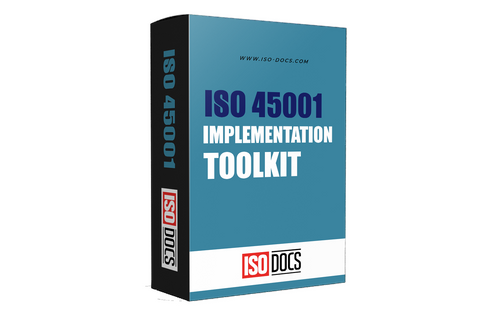ISO 45001 Checklist Template
Introduction
Work environment/workplace safety and health is a top priority for any organization worldwide. ISO 45001 standards provide a structural framework for implementing an occupational and health and safety Management System (OHSMS), which will reduce the health risk and ensure compliance and protect workers. To practice safety measures or achieve certification, the ISO 45001 checklist is an essential tool. In this guide, we will walk you through the steps of the ISO 45001 checklist that organizations can use for internal audit, gap analysis, and certification readiness.

Context Of The Organization (ISO 45001:2018 – Clause 4)
Understanding the clear idea about the context of the organization helps establish the relevance of the management system, align it with business strategy, and ensure it resolves the risks that may affect the health and safety measures.
1. Identification Of Internal And External Issues.
a) Internal Issues
Internal Issues- are related to the organization that could influence its OHSMS, examples:
- Organization structure and culture, such as management , hierarchy, and good communications, which depict how safety practices are implemented and followed.
- The capability and competence levels of the workforce play a critical role in ensuring effective health and safety outcomes.
- Additionally, existing OH&S policies, procedures, and technology resources support the management system's effectiveness, while the availability of financial, human, and physical resources determines the organization's capacity to sustain safety initiatives.
- Past incident records, including near audit findings, provide insight into potential areas of improvement.
- Finally, the awareness of safety practices directly impacts compliance and the overall safety culture within the organization.
b) External Issues
External Issues are outside the scope and can affect the system's effectiveness. Example:
- External issues influencing an organization’s occupational health and safety management system (OHSMS) include various legal, social, economic, and environmental factors.
- Economic conditions also impact available resources and workforce stability, shaping the ability to maintain safety programs.
- Additionally, supply chain risk and contractor health and safety practices contribute to the overall effectiveness of the system.
- Finally, climate and environmental conditions, such as extreme heat, ergonomic challenges, and pandemic-related risk, further affect worker well-being and must be continually addressed to ensure a safe and sustainable work environment.
2. Checklist Questions:
- Has the organization conducted a SWOT (Strengths, Weaknesses, Opportunities, Threats) or PESTLE (Political, Economic, Social, Technological, Legal, Environmental) Analysis?
- Are all internal audit reports, incident trends, or operational challenges reviewed regularly?
- How management documents issues affects health and safety objectives
Understanding Stakeholder Needs and Expectations
ISO 45001 refers to “interested parties” Whose needs influence the management system. This ensures all relevant voices are considered in health and safety planning.
1. Internal Stakeholders:
Employees and their representative
- The safest work environment that reduces hazards and promotes health.
- A protective environment and training will ensure the task can be carried out without risk.
- Access to medical support for preventive and emergency needs.
- Fair wages and career development opportunities will enhance job satisfaction and retention.
- Active participation in decision-making processes is especially important in matters related to occupational health, safety, and organizational changes.

2. Top And Middle Management
Majorly, managers play a dual role of leadership and accountability. They expect:
- Compliance with Legal, regulatory, and ISO requirements safeguards the organization from fines and reputational harm
- Risk minimization strategies that protect the employee and financial resources.
- Clear communication channels with employees, stakeholders, and regulatory bodies.
- Tools, resources, and data-driven insights to take risk-free decisions and continually improve performance
- Smooth and efficient operations to meet business goals while maintaining productivity.
Defining The Scope Of The OHSMS
The scope of the occupational health and safety management system (OHSMS) establishes the boundaries, applicability, and extent of the system within the organization. A clearly defined scope ensures:
- Alignment with organizational objectives and operations.
- Transparency for internal and external stakeholders.
- Avoidance of ambiguity during audit
- Assurance that all relevant risks, activities, and worker groups are adequately covered.
1. Key Factors To Consider When Defining Scope
- Physical sites and locations
- Head office and administrative buildings.
- Production facilities, warehouses, or workshops.
- Project or client sites under organizational control.
- Remote or fieldwork locations.
- Activities, Products, and Services
- Business Processes (eg, construction, manufacturing, IT Support, agricultural processing)
- activities such as logistics, facility management, or maintenance.
- Services delivered to clients and third parties.
- Categories of workers covered
- Full-time and part-time employees
- Contractor and temporary workers.
- Visitors, clients
- Outsourced Processes and Supply Chain Considerations
- Contractors engaged in high-risk activities.
- Outsourced Operations directly affecting worker safety.
- Legal and Regulatory Obligations
- Compliance requirements in each jurisdiction
- Industry-specific safety codes
- International or national labour and health standards.
2. Checklist For Defining Scope
- Is the scope clearly documented in the OHSMS manual, policy, or official records?
- Have exclusions (if any) been specifically justified and recorded?
- Does the scope align with organizational activities, workforce needs, and regulatory obligations?
- Are outsourced activities and contractors explicitly considered in this context?
- Does the scope provide clarity for external parties, such as auditors, clients, and regulators?
Conclusion
Improvements within the Occupational Health and Safety management system(OHSMS) involve actively recording and correcting incidents and non-conformities to prevent recurrence and promote workplace safety. It is essential that corrective and preventive actions are systematically tracked until closure, ensuring that risks are effectively managed and eliminated. Continual improvement should be a core aspect of the organization's OHSMS culture, driving ongoing enhancements in safety practices.


